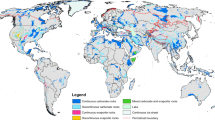Abstract
The Errachidia basin is composed of three superposed aquifers (Senonian, Turonian limestones and Infracenomanian). The Liassic limestone of the upper Atlas borders the northern part of the basin. The piezometric map of the Turonian aquifer displays a north-south flow, with an inflow area from the Atlas. This recharge hypothesis is demontrated by a discriminant analysis performed on chemical data: the majority of the spots are of sodium choride and hydrogenocarbonate types, while several boreholes are assigned to a calcium hydrogenocarbonate type Jurassic component.
18O measurements, using the Atlasic gradient δ18O=–4.18–0.0027 x elevation to estimate the recharge areas, confirm that the recharge area is the basin itself (<1100 m) on the Turonian outcrops, while in the confined part, the Turonian is recharged higher than 1400 m (corresponding to the Atlas). This contribution ranges from 56 to 85%, according to the situation versus the piezometric inflow area. The remainder represents infiltration and vertical leakage from the Senonian layers.
Similar content being viewed by others
Author information
Authors and Affiliations
Rights and permissions
About this article
Cite this article
El Ouali, A., Mudry, J., Mania, J. et al. Present recharge of an aquifer in a semi-arid region: an example from the Turonian limestones of the Errachidia basin, Morocco. Environmental Geology 38, 171–176 (1999). https://doi.org/10.1007/s002540050413
Issue Date:
DOI: https://doi.org/10.1007/s002540050413




